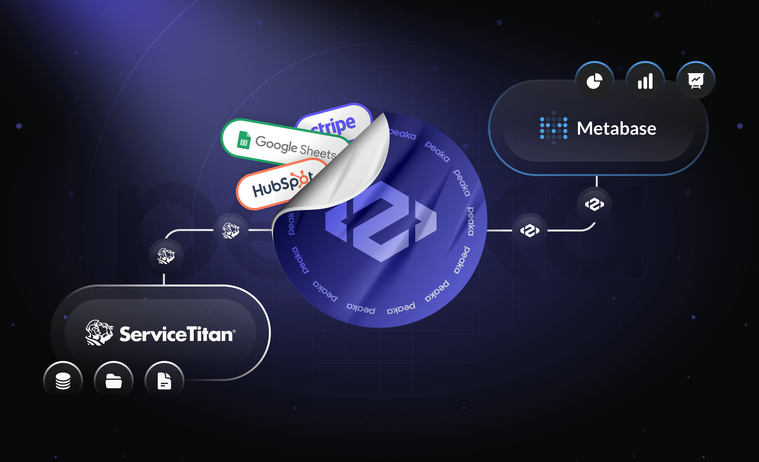Connecting ServiceTitan to Metabase with Peaka
How do you grow a home service business? By expanding into new locations so you can be closer to your customers? By adding new trades to the services you provide? Or by just running a tight ship, filling every empty slot in your schedule, and making the most of every customer call? Regardless of which option you choose, you need data to implement your strategy.
This is not an ordinary plea for being data-driven just because it’s the trend now. Being data-driven is the only way out of mediocrity if you don’t have a cool app with virality built-in. In a commoditized service industry, home service businesses should leverage their data and drive efficiencies if they are to grow.
Luckily, blue-collar services like the trades have ServiceTitan to centralize their data. The California-based software company has carved out a niche for itself by building a platform that caters to the needs of the plumber, electrician, or HVAC service in your neighborhood. The company successfully nurtured this segment, reaching thousands of customers and hundreds of millions in ARR and eventually going public in December 2024 at a valuation of nearly $9 billion.
What is ServiceTitan?
ServiceTitan is a CRM platform purpose-built for the needs of home service businesses or trades. It is a one-stop shop for these organizations, assisting them in scheduling appointments, assessing employee performance, managing customer calls, tracking job progress, and measuring customer satisfaction.
Recognizing that home service businesses, too, have varied software needs, ServiceTitan expanded, eventually encompassing modules that can handle purchasing, communications, and inventory management tasks. For local businesses planning to lean into paid ads to grow market share, the platform offers a Google Ads integration. Combined with the reporting and dashboard capabilities of ServiceTitan, this integration empowers business teams to turn their insights into timely ad campaigns.
We will go into the details of the ServiceTitan dashboard below, but suffice it to say that it brings to the table a much-needed capability, allowing users to turn their data into visualizations and metrics that reveal hidden trends. Although it does not have the customizability that the best business intelligence (BI) tools offer, the ServiceTitan dashboard still allows users to view the essential metrics and KPIs their business requires.
What is Metabase?
Metabase is a popular BI platform going up against some of the powerhouses in the market, like Looker Studio, Power BI, and Tableau. Metabase stands out from the competition with its open-source foundations, but the platform offers paid tiers for advanced features and more comprehensive customer support.
Unlike Looker Studio, Power BI, and Tableau, which cater to more varied customer profiles ranging from startups to enterprises, Metabase boasts a feature set that is a better fit for startups and SMBs. It packs a few capabilities that should appeal to organizations with small data teams:
Models
One of the biggest challenges organizations face is making data accessible to domain experts with limited technical skills. Metabase offers models to fix that problem. Models are templates that combine queries with meta descriptions, giving data a more uniform structure. Thanks to this feature, users can bring in data from different tables, change the column names, and add calculated columns, ensuring teams work with the most relevant data for their roles.
Query builder
Metabase turns SQL querying into a point-and-click kind of task with its visual query builder. If you are a non-technical user or someone just not confident in your rarely-used SQL skills, this feature allows you to query your data to draw business insights.
Pre-made visualizations
Metabase comes with sixteen built-in visualizations that facilitate creating dashboards. Users can further customize these templates to create the perfect visualizations for their datasets.
SQL editor
Most startups and SMBs rise on the shoulders of one or two data professionals if they have any. Metabase offers a query editor that enables these people to use the language they are fluent in: SQL. Technical people can use this powerful tool to generate the more detailed reports requested by business teams.
Metabase leverages these features to serve two use cases: Self-serve analytics and embedded analytics.
Self-serve analytics describes the primary use case wherein Metabase connects to various data sources to turn tabular data into visualizations. This is how users generate reports and create dashboards with their data by filtering it with the SLQ Editor or the Query Builder.
Embedded analytics use case applies to B2B businesses that want to add a customer-facing analytics capability to their feature set. Instead of building a data visualization tool from scratch, businesses can embed Metabase components into their product and customize the access controls and the level of interactivity they want to offer their customers.
The ServiceTitan dashboard
ServiceTitan functions as a command-and-control system for a home service business. It supports integrations with more than a hundred different data sources, which centralizes data for analysis and insights. Tax data, accounting records, payments processed, or HR-related information… ServiceTitan connects with the relevant platform to fetch whatever data you need. Moreover, it helps align the office teams with the teams in the field.
The reason for centralizing data from different sources is to turn it into actionable insights. That’s what reports do. ServiceTitan provides users with a robust reporting capability that can be tailored to the requirements of a specific business. Users can pick from tens of different attributes to generate the perfect report for their purposes.
ServiceTitan’s built-in dashboard helps users turn their tabular data into visualizations so they can track metrics and KPIs. There are four main types of metrics the platform provides:
-
Business metrics (sales, revenue, conversion, etc.) to track overall business performance.
-
Call metrics (calls, bookings, and conversions) to generate new leads.
-
Customer Service Representative metrics (inbound calls booked, taken, and leads generated) to evaluate the performance of a call center employee.
-
Technician metrics (average response time and job completion rates) to monitor the performance of field workers.
The ServiceTitan dashboard facilitates trend analysis as it produces historical data for the last 18 months or 26 weeks. A careful study of this data can reveal insights that can be used to make projections for the future.
In addition to the pre-made visualizations, ServiceTitan offers two types of ready-made dashboards to make things easier for non-technical people: The business status dashboard for monitoring business opportunities and job completion rates and the commercial dashboard for viewing business metrics like revenue and sales. These dashboards can be tailored to a certain extent to provide more granular information.
Why should you connect ServiceTitan with Metabase?
The data needs of organizations can be surprisingly diverse. Even in a seemingly uniform industry like home service, location, regulations, local customs, and customer demographics have an impact on the way companies are run. This, in turn, informs how data will be reported and visualized.
ServiceTitan is a CRM platform, first and foremost. Its dashboard is an add-on that does a respectable job of visualizing data. However, it lacks the customizability to respond to niche visualization requirements, for which a purpose-built BI tool will be a better fit. These tools offer proven solutions that can be infinitely customized to specific needs.
Metabase is a particularly good fit for ServiceTitan customers as it prioritizes ease of use and primarily serves startups and SMBs. Home service businesses are highly unlikely to employ data professionals who can use highly technical data visualization platforms. Metabase’s simplicity, customization options, and pre-made visualizations allow non-technical users to self-serve, which is exactly what a typical home service business needs.
However, ServiceTitan does not readily integrate with Metabase at the moment. Manually copying your home service business data to a spreadsheet and importing that data to Metabase for visualization can be an option. However, in a dynamic work environment where data keeps flowing in from the sales, marketing, and fieldwork teams and dashboard needs abound, this is neither sustainable nor realistic. Fortunately, there is a more practical and scalable solution.
Using Peaka to visualize your ServiceTitan data with Metabase: Benefits
A seamless integration between ServiceTitan and Metabase can combine the former’s reporting capability with the latter’s slick data visualization, unlocking immense value for users. Such an integration can significantly lower the technical barriers to data analytics, allowing even non-technical employees to draw insights from their data.
You can always solve this problem in the conventional way using a data warehouse and a data team. In this scenario, the data warehouse acts as the spreadsheet in the above example: It is where you move your data after copying it.
However, it is not as straightforward as copying & pasting data because you need to build data pipelines between the source and the destination so the data gets transferred with the necessary format changes. These data pipelines need to be rebuilt whenever the input or output format changes, causing a huge maintenance task that requires a data team to handle. The cost of running a data warehouse and employing a data team renders this option unfeasible for home service businesses and SMBs.
Peaka has a unique approach to this problem: Using data virtualization, which lets you view all your data as a relational database, regardless of the source. You can then join this virtualized data with data from other sources, form new datasets, and expose them to other systems and applications.
Data virtualization simplifies how you can access your ServiceTitan data and enrich it with data from other sources. When you want to tap into your ServiceTitan data, Peaka allows you to overcome the data engineering challenges with a ready-made connector. It also integrates with Metabase along with other popular BI tools.
Thanks to this approach, you can query your ServiceTitan data, join it with your CRM or SaaS data, and send the end result to Metabase for visualization. As you probably noticed, there is not a word of a data warehouse or a data pipeline in the whole process.
Peaka’s ServiceTitan-Metabase integration produces four major benefits for a home service business:
-
Reduces backlog for data teams as it empowers non-technical employees to self-serve and generate reports on their own.
-
Allows home service businesses to use their scarce technical sources for more critical tasks.
-
Minimizes human error by eliminating manual copy & paste from the data integration process.
-
Helps save money as it removes the need for a data warehouse or employing a bigger data team.
Conclusion
One of the goals of data integration is to break down data silos, bring together the data scattered across multiple systems, and form a single source of truth for data users. Another goal is to share your data with other applications and systems so you can take advantage of synergies and leverage new capabilities.
Our ServiceTitan-Metabase integration does just that, combining a specialized CRM like ServiceTitan with a dedicated BI tool like Metabase, giving you the best of both worlds. Although conventional data integration can be too costly and complicated for SMBs, Peaka simplifies things for these organizations with a universal middleware. The result is a seamless data flow from ServiceTitan to Metabase, slick visualizations, and profound business insights.
Visit our documentation to see how you can connect ServiceTitan to Peaka.
For step-by-step instructions on Peaka-Metabase integration, see this document.
Make sure you read our blogs on connecting ServiceTitan to Looker Studio and Power BI if you’d like to see more BI tool options.
Check out Peaka’s growing library of custom connectors and book a free demo to see Peaka in action!




 Please
fill out this field
Please
fill out this field









